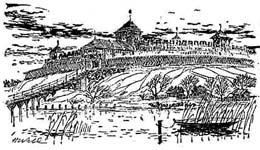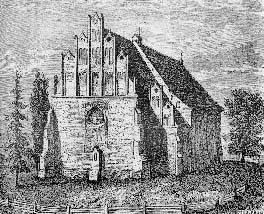|
|
|
|

|
|
Draft of the city of Wizna
in the Middle Ages,
a reconstruction based on
archeological excavations.
By: H. Wilk |
|
| |
|
WIZNA - a village, once a town. Situated
on the right, high bank of Narew [a river in Eastern Poland]. It has a 900
years' long, documented history. In the Middle Ages, Wizna was invaded by
Jadzwings, Lithuanians, Prussians and The Order of the Holy Cross. In 1435, the
village received its rights and became a town. The most prosperous period was in
the 16th and 17th century. From the 18th century, Wizna declined economically
and the number of its inhabitants decreased. In the year 1939 [at the beginning
of the WWII] Wizna was the site of heavy battles against German invaders. Now it
is a village with a population of about 1700, a typical agricultural village.
Translated from:
http://www.sudety.info.pl/wizna-los
|
|
|
|
 |
|
Church in Wizna |
|
|
| |
|
The remains of a Duke's Castle and settlement under the castle are situated on the separated
promontory, on a high slope of the Narew River.
The history: In the 12th century there was a castellan settlement, besieged and destroyed many times
by the warriors of Jadzwing, Prussian and Lithuanian tribes, and subsequently
restored. In 1294, the castle and its surrounding settlement was burned down by
the Teutonic Order knights. But soon, in 1296, a Mazovian Duke, Boleslaw II,
(born after 1251 and died in 1313) reconstructed it. The dirt ramparts of the
castle were made higher and its slopes were supported by stones. In 1388, the
castle was conquered and destroyed by Lithuanians. From 1402 it became the
property of Janusz I (born about 1340, died in 1429), the Duke of Warsaw,
Ciechanow, Wyszogrod, Zakroczym. Liw and Wizna. Supposedly at that time, inside
the castle and the settlement surrounded by high wooden-dirt ramparts, the first
brick houses were erected. The local population put them down in the 2nd half of
the 19th century. A methodical archeological research began in 1967. This work
helped to restore the primary location of the castle and the settlement on a
promontory slope, cut by a moat in the North. The Narew River defended the
castle from the East, and marshlands defended it from the West. The
archeological research showed some stages of the construction of the castle.
Fragments of stone foundations were found, made of field stones. They might be
the foundation of a tower, mentioned by historians at the end of the 19th
century. Right now the main goal of the archeologists is to find if there
existed at the castle and the settlement of Wizna (of 14th-15th century) simultaneously,
wooden-dirt ramparts and brick houses and some defense buildings, such as a tower, walls and a gate.
Translated from the following no-longer functioning site: http://www.zamki-mazowsza.turystyka.net/html/wizna.html
|